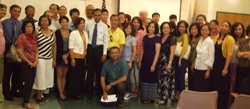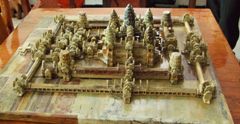Clothing
|
Sampot |
Av
|
Clothing By Period
|
Sampot
The sampot is the national garment worn mostly by Cambodian women, but there are types of Sampot that are worn by both man and women. The sampot dates back to the Funan era, when a Cambodian king allegedly ordered the people of his kingdom to wear the sampot at the request of Chinese envoys.
There are many variations of the sampot; each is worn according to social class. Also, these clothes vary in color, shape, and size. The typical sampot, known also as the sarong, is usually worn by men and women of lower class.
Sarong
Sarong is a type of Sampot that can be worn by both men and women. It is daily wear. Family with strict protocol only wears Sarong around the house. But some people may wear outside the house or when for instance, going to get something from the store nearby. There are variations of cloth that made up Sarong. It can be made from cotton or silk. Sarong can be also used as night outfit, usually the Silk Sarong.
Sampot Chang Kben
Sampot Chang Kben was once the preferred choice of clothing for women of upper and middle classes for daily wear. The practice has died out in the beginning of the twentieth century. It dates back to ancient Cambodia where deities were said to wear such styles. Sampot Chang Kben is more like a loose pant from the look when a person wears it. It is a rectangular piece of cloth measuring three meters long and one meter wide wrapping up around the waist and rolling at one end like a knot or tail that goes between legs to the back. A piece of clothing string is used to snap it up to waist. A golden or silver belt is used on top of the string for women as blouse usually goes underneath the Sampot. For men, the belt is used on an outfit garment.
Sampot Phamuong
Phamuong refers to variations of traditional Khmer textiles made from silk. They are single colored and twill-woven. Phamuong Chorabap is a luxurious fabric woven with up to 22 needles. The most valued silk used to create the Phamuong is Cambodian yellow silk, known for its fine quality. New Phamuong designs draw inspiration from ancient silk patterns and usually contain floral and geometrical motifs. Phamuong can be used for Sampot Chang Kben, skirt, evening outfits, and more.
Sampot Hol
Sampot Hol is another typical traditional textile made from silk. It has become a genuine Khmer art style for hundreds of years. The sampot hol comes in over 200 patterns and three to five colors (yellow, red, brown, blue and green). Patterns are usually animals and geometric or floral motifs.
Both Sampot Phamuong and Sampot Hol are believed to have originated from the original sampot in Udong Era. Although neighboring Thai has similar clothing, Khmer weaving bears its uniqueness.
Sampot Tep Apsara
Sampot Tep Apsara is a famous type of sampot from the Khmer empire era. It can be found on the bas-relief of Apsara carved around Angkor wat. Generally, the sampot tep apsara is tied to safely secure it on the waist and is held up with a golden belt. A long pleat is dropped at the middle of the sampot and recoils at the wearer's calf. The hem of the skirt is knotted. There are also two knots that hang from the waist; the left knot is longer, while the right knot is more decorative. The sampot tep apsara is no longer worn daily in modern-day Cambodia.
Sampot Samloy
Sampot Samloy is a long unisex daily-wear skirt. The color is usually black. Today, it is recognized as the soft, thin fabric with decoration and pattern. Sampot Samloy is worn by women similar to skirt or Sarong that may be folded to the left or the right of the waist and knotted against the waist belly. Its usage starts from post-angkor eara. It is still commonly used today.
Sampot Pre and Anlounh
Sampot Pre and Anlounh are another type of Sampot that was once very popular for the middle-age Cambodian peasant during early 20th century. Their characteristic is they are made of from shiny, soft black cloth with flowery gradient pattern. While Sampot Samloy is for daily usage, Sampot Pre and Anlounh are used for special occasion such wedding ceremony, going to the Buddhist temple, etc.
Sampot Chang Pong
Chang Pong is a piece of fabric in any color worn by Khmer people at the end of the 13th century. It was primarily worn by women, who started using it to cover their chest leaving their shoulders uncovered. Often, a women wears Sampot Chang Pong for bathing near a pond or to fetch water from the pond with Khaam, a water container made from clay.
AV (Shirt)
There are many variations of top wears known as Av in Cambodia. The invention of the traditional Av occurred after the Khmer empire era, at the turn of the 14th century.
Av Bumpong
Av Bumpong is a tube type of dress that looks like a long tube, bribe to the body at the head and drop down easily. Generally, It has a collar with a button at the length from the neck to chest and it is normally narrow at the middle around the waist. Most Av Bumpong has length to heel. Few shirt styles have a length to just below the knee. This type of shirt is famous during Lovek to Oudong era worn by rich lady. During early Chaktomouk era, it is commonly wear by all Khmer peasants. Presently, the Khmers discontinue wearing it.
Av Pak
Av Pak is a recent popular fashion blouse in Cambodia worn by women. It is a plain stamped cotton elaborately hand-painted embroidered silk with gold thread. In the past, this kind of shirt required its own unique style with only white color with the high full of embroider. Today, This shirt has more gold thread in several color and had cut into a lot of modern fashion which highly popular to Khmer people especially middle aged and young woman with the narrow style and several decoration model. This shirt had been noted as today's khmer national costume where a lot of Khmers girl had used this blouse at the special occasion both inside and outside Cambodia to revive the khmer identity. This shirt usually worn with Sampot Hol and a few worn with Sampot Chang Kben.
Clothing By Period
Cambodian clothing varies by region, time, and social class over the years. Traditionally, Sampot with many variations is regarded as national dress of Cambodia for Women. Each era carries the style from the previous era and add on new fashions with some variations. Some clothing styles disappeared through the new era for long times, only to be restored in another period due to their popularity.
Funan Era (68 AD 550 AD)
The first period of Cambodia, Funan, the earliest fashion style to Khmer people is totally influenced by the India. Some clothing styles in this period bore high similarities to Indian fashions until the popularity of Sampot came to the country after a Cambodian king ordered the people of his kingdom to wear the Sampot at the request of Chinese envoys. Despite some similarities in dress, men and women wore distinct clothing styles.
Men: All males in the region generally wore Sampot Chang Kben but different from today style. The noblemen, royalty and king preferred their own style in Sarabat textile, imported from China. A bas relief evidence depicts that the wealthy people wore their clothing by tying it around the upper body and tying the waist with a thin piece of cloth.
Noblemen and royalty wore Sampot Chang Kben in everyday life with the chest exposed. With the spread of Hinduism across the country, the King always crowned with long corner crown in different color that depicts their royalty.
Women: Women wore Sampot in different colors, wrapped with a beautiful golden belt at their waist. The most useful sampot is Sampot Sarabap, made from the expensive light silk. They left the upper body exposed. They used a collar known as Sorong Kor and beautified themselves with jewelry such as the big triangle earring made from wood or gold or another kind of earring similar to bracelets.
Short, straight hairstyles were popular among common folk; the chignon was typically reserved for royalty. Unlike rich people, poor people wore a simple straw skirt cover around their waist or a skirt made from animal skin or cotton. They habitually had no jewelry but wore a similar hairstyle to rich people.
Chenla (550 AD 802 AD
Khmer Chenla carried on their clothing from Funan era and add its own uniqueness to style. According to the bas belief at Vat Phou, a still ruin of Chenla, its national costume differe significantly from that of Funan with the exception to headdress which was reserved only for the king during that era.
Men: men continued to wear the Sampot in variations and would tie their hair into a chignon and crown it with a Funan-style headdress They wore a kind of Collar due to half body undressed showing up muscle to show they are strong, and when holding up a sword to show they are brave.
Women: women also tied their hair into a chignon, adorned their head with a beautiful flower, jasmine or rose. They would also crown their head with a round floral headdress made of gold. They also wore Sampot or a floral textile Sarong with a golden belt. They wore a new style of khmer sorong kor below their neck despite exposing their breast and stomach.
Angkor Era (8th century to 14th century)
Khmer Empire or Angkor period strongly marked a more of a Khmer fashion style than Indian of the previous period.
Men: Most men had their chests exposed, walked barefooted and wore only a piece of cloth wrapping around their waists known as Sampot and golden belt around it. Other men wore a heavy silk gold, black or white short with a hand design on the legs. Instead of Golden Belt, they also wraps around the waist with Khmer's Krama and wear Sarong as well. There were two hairstyles: one is a regular ornament as straight hair; the other is a Chignon style.
Women: women wore their traditional Sampot and Sarong, but left the upper body part uncovered. Their Sarong and Sampot are longer than men's and had a lot of Knots. Common women had no hair ornaments, though some wore golden rings or bracelets and metal belt. Another evidence illustrate that average lady and rich lady in that era, used a golden buckle to cover this upper body and normally, has a Chignon hairstyle but allowed a large of poly tail, on their shoulder.
Apsara: Apsara is a celestial dancer for royalty in Angkor Era wearing a khmer clothing ornament known as Sorong Kor, a gorgeous round decorative Collar, usually in red. It is worn just below the neck. The collar is embellished with detailed gold colored copper ornaments and beaded designs. It includes a loosely decorated with band of beads worn crosswise called Sangva. They wore only Sampot, but more decoration than ordinary Sampot. This type of Sampot has two knots around the waist. The right knot is long knot but left knot design more charming and fashionable. They cover their waist with a high professional design belt, decorated with warped spear-like tips draped on a red cloth. Their most used jewelry are Ankle Jewelry, Dangling Earrings and Wrist Jewelry but best of all is their crown that features three points and two or three garlands with ornate adornments, made of Emerald and Gold.
Royalty: They wore their own type of Funan and Chenla's costume as well as the Angkor era style with more ornaments and decoration to show royalty. However, the court lady and Queen have no different appearance than of Apsara. They wore special Sangva and Sorong Kor, made from silk and featured golden twinkle floral printed instead of regular bead as Apsara. Their crown had ten points and a large diamond center on headdress.
Chaktomuk period (1437 AD 1525 AD) and Later
After a long lost war, Cambodian survivor aware of the lost to the original way of living. They then created new style with a unique Khmer thinking. Still, they had no tops to cover men body, but they had a nice fabric to cover lady top.
Men: Most of men in general preferred shirtless. Only the wealthy can afford to wear tops to cover their body. Ordinary Khmer male's attire was clothes that wraps around the body like Chang Kben in several color, but just from the waist down to their thigh so they can easily perform to works. The Noblemen or lord always worn a round collar shirt with a long pleat at the front and four pockets, two at each side. During that period, most men had long hair.
Women: Lady in this period beautified themselves with lots of decorations to their garment made from fabric highly decorated with several colors and many pieces jewelry. Later in the period the Khmer developed a more tighter and stronger, solid color weaving fabric. They start to cover their tops and sewed cloth into one piece to avoid accidental drop off. They also tie a lovely, big and soft shawl around their shoulders or down to the center of their back but hold it on their arm instead. They wore a wrap-around skirt called Sampot Samloy in their favorite color and textile. They also wore jewelry such as Bracelets, necklace and earring, made from silver, gold and metal. Usually, the female elders had their hairstyle as Chignon style. Average Khmer female wore black cloth and Sarong with no decoration for a daily wear. They always woret Krama.
Royalty: Monarchy fashion are the most elegant of all. The King worn a long sleeves shirt at the top sewed with a hugging arms in rich embroidering. The collar is highly decorated. They wear a criss-crossing piece of cloth called kse-sangvar, a chains of rank that forms an 'X' in front of the body.The kse-sangvar is decorated with a diamond shaped pendant. Their garment is long and is hugging over trouser with some decoration. They also wear special Sampot Chang Kben. The King wears crown with a similar crown of Angkor period but more sharp tip and high.
Black pajamas
The Khmer Rouge regime of the 1970s was well-noted for popularizing black unisex "pajamas." The typical peasant outfit consisted of a collarless black shirt, baggy trousers, and a checkered krama knotted loosely about the neck. Brightly colored clothing was strictly prohibited under the Khmer Rouge; colors were limited to black, dark blue, or maroon plain coloring. Women were strictly forbidden to wear any Western-style trousers or jeans at any time, although after the fall of the Khmer Rouge, these became increasingly popular, particularly among young women.
Today Cambodia
Influenced by technology and modern lifestyle, the Khmer wears western-style trousers, blouses and dresses. Clothing is mixed: modern and traditiona. They still keep the tradition alive for special occasion, wedding, Buddhist festival, etc. The schoolgirl wears a dark blue skirt that sometimes just a little bit above or below the knee. They wear while blouse. The schoolboy wear a khaki pant and while shirt. Working clothes vary, mostly western style. The elders are more traditional than the young counterpart.








